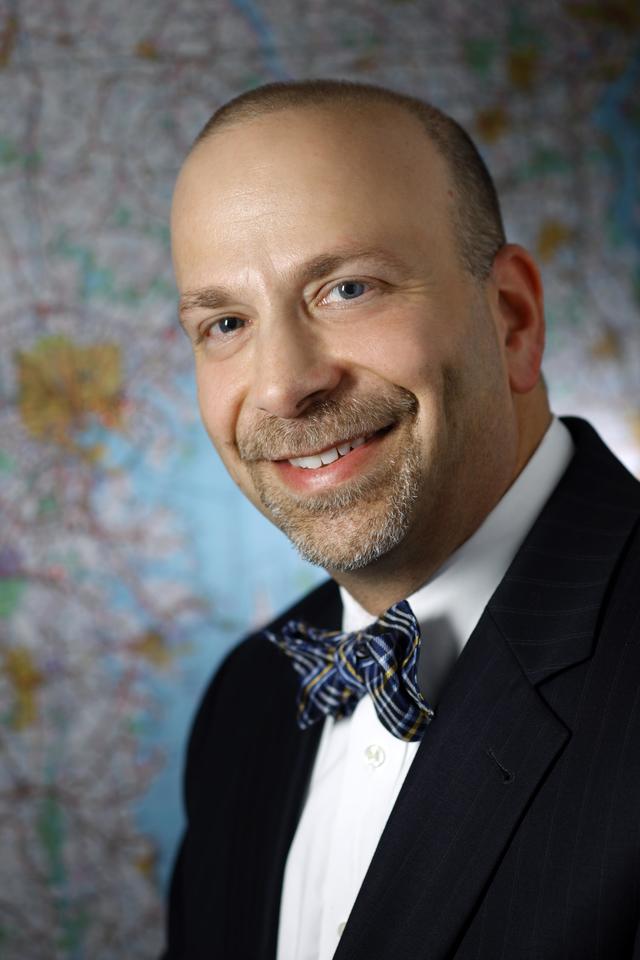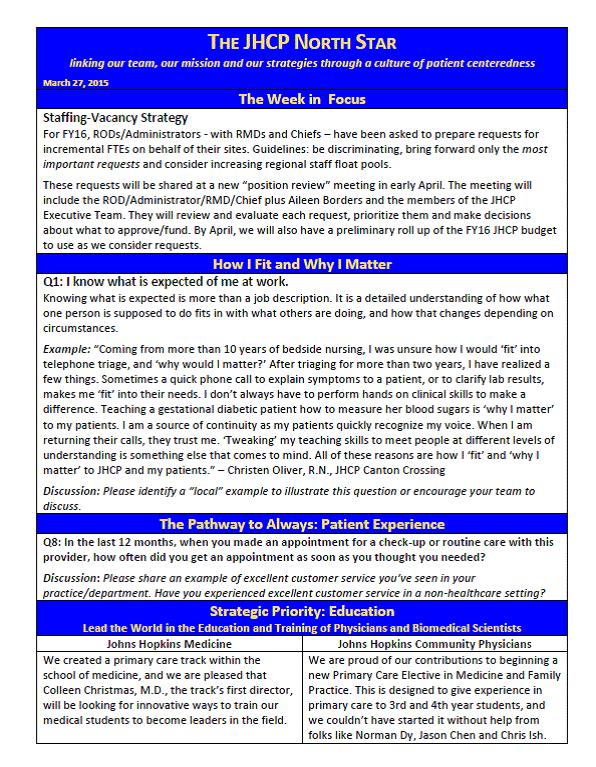Blogrige
The Official Baldrige Blog

Steven Kravet; photo used with permission.
The following interview highlights how 2014 Baldrige Executive Fellow Steven J. Kravet, M.D., M.B.A., F.A.C.P., has drawn on cross-sector learning from leaders of Baldrige Award-winning organizations to advance his health care organization’s performance. As head of Johns Hopkins Community Physicians, Kravet has created and launched a systematic communications plan to better connect and engage a diffuse workforce of approximately 1,600 physicians and staff members with the organization’s mission and strategy.
First, could you please tell us about Johns Hopkins Community Physicians and your leadership role?
I am president of the organization, which has about 400 physicians and about 1,200 employees altogether and 40 practices across the greater Baltimore, Maryland, and Washington, D.C., region providing primary care, specialty care, and hospital-based care. We are integrated into the Johns Hopkins Health System [of John Hopkins Medicine]; all of the physicians and all of the staff members of Johns Hopkins Community Physicians (JHCP) are employed by the health system. (Physicians affiliated with Johns Hopkins in private practice may teach in or have other relationships with the system, but the only physicians employed by it are either the full-time faculty members of the [Johns Hopkins] university or our physicians of JHCP.) I report to the president of the health system. I have a leadership team, including clinical, operational, quality, and finance leaders to oversee this organization. We’ve been in existence as an organization for over 30 years. I’ve been in this role for six years. I’ve been with Hopkins overall for 23 years.
What was the value of the Baldrige Executive Fellows program for you as a leader?
I had long been a fan of the Baldrige [Excellence] Framework. Having the opportunity to dive in deeply to the background and philosophy as well as the opportunity to see the framework in action was priceless. From the onset of the program, I was able to take elements back to my organization, which I am certain has paid back the cost of the program several times over already.
Tell us about how you’ve applied learning from the Baldrige Fellows program in your work?
Sure; some specific work that’s been under way is about enhancing the patient experience. We’ve worked on some principles of service excellence and employee engagement learned from the Ritz-Carlton and from K&N Management—two Baldrige Award winners to which I was exposed through the Baldrige Fellows program. We’ve enhanced our communications strategy—that was my capstone project—which is in some ways similar to what the Ritz-Carlton program is all about. And we’ve begun looking differently at staff development. We’ve also begun to talk about how visual displays of data could help us in our performance-improvement activities. Some of those things are mapped out as plans for the next several months. I’m hoping to take advantage of the generosity of the Baldrige Award winners to host members of my executive team to take a deeper dive into some of those elements. My entire executive team attended the Baldrige Quest for Excellence® conference [in April], which was great. It generated lots of conversations about the “art of what is possible”—the sense that Baldrige is something that is inspirational and achievable, with the right focus. Immersing the team for three or four days was a really valuable part of the experience. Our hope is to dive more deeply over the next several months.
Would you please elaborate on how you’ve enhanced your organization’s communications strategy through your capstone project for the Baldrige Fellows program?
Sure. I set out to create a more well-defined and structured communications strategy following two basic principles: One is the notion of a cycle of communications linked to strategic planning. The concept is to have bidirectional communications to help influence our strategic planning process and solicit input more purposefully from the front lines of the organization and also from the board of trustees and other levels of our organization, as we set out in our strategic planning. And we did that over the course of this year.
The other cyclical component that is part of the capstone is to have a link to the mission and vision statements of Johns Hopkins Medicine and the strategic priorities. So what we’re doing is having themes that repeat over the course of the year. We have six strategic priorities at Johns Hopkins, and the goal is to have each of those strategic priorities reflected two times throughout the year as a component of our communications strategies.
And then, in each of those months when we focus on one of those strategic priorities, we would have a multimedia modality approach toward communicating them. The reason for that has to do with an assessment we did where we discovered that people across the organization have very different desires for how they like to receive information. Some people like e-mails or newsletters, some people like staff meetings, and some people like to watch webinars. So what we’re doing is taking the theme of the month and spreading them across all of the media modalities so that everybody will have heard the same message.
The newest form of communications is one I adopted from the Ritz-Carlton, which that organization calls a “daily report” or a “daily line-up.” Our “Week in Focus” is a set of talking points that are scripted and balanced; those will be distributed to management throughout the organization, with an expectation that, at some level in the organization, they will be read aloud to a unit of employees. So once a week everybody is going to hear a set of talking points that are based on what members of the executive team think is most important to communicate. The purpose is to make sure everybody is hearing the same message.
Would you please describe how the weekly communications are structured?
The entire report is called The JHCP North Star; my capstone was entitled Galactic Communication Strategy: Bidirectional Communication to Improve Connection to Mission and Perceptions of Opinions Count in Johns Hopkins Community Physicians. The reason for the galactic reference is the notion that, just like our solar system creates a cycle of seasons, it’s valuable to have a cycle to communications. The “north star” reference is to the notion that we all need a guidepost, or a beacon, that helps give us direction—so we are linking everybody to the organization’s mission through this North Star strategy.
The first section is “The Week in Focus” and communicates the most important points of the executive team. The next section has to do with employee engagement. What we’re doing in this section is linking in a structured way one of our eight core values or one of the engagement questions from the Gallup Q12 survey. There will be a different theme each week. We will share an example and explain that we want them to have a discussion on other examples in their particular unit. So, for instance, there might be a question about having all the right tools to do their jobs well; we’ll give them an example of what that means and ask them to have a discussion on how they’re ensuring in their unit that they have all the tools to do their job well.
The next section is about the patient experience; in that section, we go through a series of questions from our patient engagement surveys. We’ll ask how, in their role, they’re ensuring that patients are receiving patient-centered and excellent care. If the question is about access, for instance, we’ll give them an example about what patients might perceive about access, and we’ll ask them to have a conversation in their unit to talk about what they are doing in their unit to ensure access. The next week, the theme might be about patient communications skills or about wait times. So each week, we’ll have a different engagement theme for staff and a different patient-experience theme.
The last section relates to strategic priorities. In each weekly communication, we’ll include one bullet with an example of a strategic priority at the Johns Hopkins Medicine level and one bullet with an example of a strategic priority of Johns Hopkins Community Physicians. For example, one strategic priority is about discovery, so we’ll share something going on about discovery at the Johns Hopkins Medicine level and something at the Johns Hopkins Community Physicians level. By the end of the month, there will be four examples for each, and those will be captured in a monthly newsletter. So even if employees miss a weekly report, they all have an opportunity to read the summary.
Is there a common time and forum for the planned weekly discussions based on these communications at units across your organization, or does each group figure out what works for them?
Closer to the latter: some units have weekly staff meetings; if they don’t, there might be a huddle. The expectation is that all employees will spend at least five minutes each week connecting to the [Johns Hopkins Medicine] mission.
What challenges have you faced in developing and implementing this initiative, and how have you overcome them?
Part of the challenge is that people are busy, and when we give them more things to do, they have to believe that this extra communication that we’re asking them to do is going to ultimately help them. It’s like saying to somebody, “I know this medicine tastes bad, but it will make you feel better in the end.”
There’s a lot of trust in that. We’re trying to get people to respect that this is an important strategy. I think one of the important parts is that we acknowledged that we had an opportunity to improve [employee] engagement. There was clearly a case for change that we wanted to address. In a series of surveys that we did in the beginning of planning this, we asked people how they wanted to receive communications; we also asked them how they wanted to shape the direction of the organization. So we were really trying to address the issue of how their opinions count all along the way.
How is this all progressing, and how will you measure the impact?
My goal was to launch the new tool by the end of the year. Our first four weeks of communicating with this new North Star communication tool will be complete by June. So we have the draft all done. We’ll refine it month by month. We’ll try to get some feedback from folks about the communication tool: Is it readable enough? Is it relevant? Is it something that we want to serve up for them to be read, or do we want to encourage more engagement through conversation?
We’ll measure our success in relation to two specific elements of our workforce engagement survey—one is about employees’ connection to the organization’s mission, and the other is about employees’ feeling that their opinions count. Our 2013 results for those two survey questions had decreased significantly from the previous year. So the annual engagement survey administered by Gallup is one measure.
How do you see the project evolving in the future?
What we’re hoping to do overall with [the Baldrige framework] over the next year is to assign categories [of the Baldrige Criteria for Performance Excellence Criteria] to each of the members of the executive team. Our hope is that over the next two or three years, our organization might be prepared to do a state [Baldrige-based program assessment/award] application.






